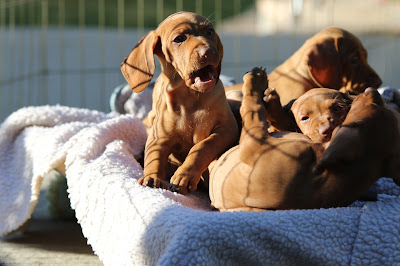The hardest part of raising a puppy is not to stifle them. Yet we must be there to protect them every step of the way. Finding that balance, between freedom and protection, is a difficult one to find. We want to tend to their every need, and cuddle away every whimper, and when we do, we stunt their emotional growth. We keep the fearful ones fearful, and the bold ones simply find us irritating.
Our puppies must learn to problem solve, and work out their own difficulties. Our job is to find the balance of when to help them, when to give them a kiss and a nurturing shove forward to work it out on their own, to know when to laugh at them for the dumb error that they just committed, when to force them to succeed and then reward them as though it was their own brilliant idea, and when to simply protect them and keep them safe.
When raising a puppy, I use what they offer to build their confidence. My past two weeks have been spent with two wonderful baby boys. Both are needing help dealing with big adult dogs at the park. Both pretend to act over confident and 'cool' when they really would rather climb inside my jacket and be carried! Growing up is scary, and my understanding and help, and hand-holding, has given them the courage to act like stellar lads.
My first little man had a fabulous temperament, and fabulous raising thus far, so he only needed teasing reminders such as "Grab your Ball" when passing a dog. By keeping his mind on the soother in his mouth, his manners were spectacular, and he had the confidence to move on past temptation.
My second little puppy could not have been more different. He had no social skills, and only confidence through his teeth, so pretended he was the biggest and toughest dog in the world. He needed to be carried past dogs and see them from the safety of arms. Then he needed to be on the ground, with hands guiding him, reminding him that is was me and him against the world. Now we are at the stage of going past the dog, and throwing a cookie in the direction that I want him to go (straight past). I am giving him a reason to leave the encounter. I'm not forcing him. It is his choice to leave (so he keeps all his power). I've just presented a darned good reason why he should leave. This little man has given me his heart and soul. He tries hard to please - but he has no idea how to behave. It is my job to show him how. Because of all that he has missed, he is never going to be the role model at the dog park. But he can learn manners, and how to be a well adjusted, confident adult, by being schooled on what is wanted, and by watching my well behaved adult dogs demo for him.
We are repeatedly told that dog training is science. I disagree. I think it is more like art. Each dog is a blank canvas, and it is up to us to create our perfect dog. We are given a topic, and then the creation is left in our own hands.
There certainly is a scientific component to it; If you do this - you will get that. But first you must envision your canvas so that you know what you want to create, and then you use your science to help you get it.
This is the reason that if you present one problem to ten dog-trainers, you will get ten answers. All might be right, but each trainer will create a very different canvas, depending upon what they saw.
Monique Anstee
Victoria, BC
www.naughtydogge.com


























